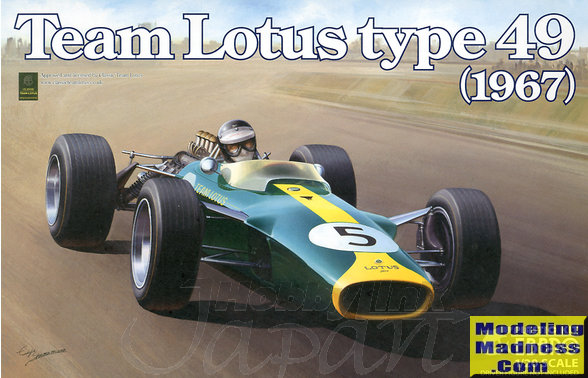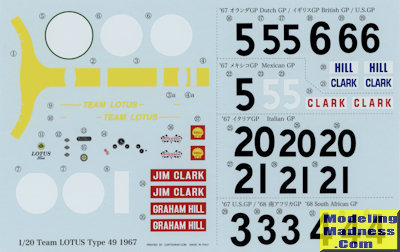
Ebbro 1/20 Lotus 49
| KIT #: | EMSF-1 |
| PRICE: | $59.95 SRP |
| DECALS: | Many options |
| REVIEWER: | Scott Van Aken |
| NOTES: |

| HISTORY |
For those of us at a certain age there are periods of time that tend to draw our attention. When I was in the car crazy stage that was the norm for American males in the mid-late 1960s, it seemed like the golden age. This was the time of big block American cars, the start of the Can-Am and Trans-Am series in the US, the hay-day of sports and prototype racing in Europe and the US as well as other places around the world, and Grand Prix racing, which is now universally known as Formula One.
When I was first drawn to racing cars, pretty much what you'd see at races had an engine in front of the driver. However, Grand Prix cars started the rear engine revolution in 1959 and in a few years, they were all so designed. This filtered into other types of racing such as sports cars and Indianapolis cars. I used to follow these events the best I could through clippings from the newspaper and a bit later from the race reports in Road & Track.
It is interesting that at the time, I had very little interest in NASCAR and USAC stock car racing and a lot in Grand Prix racing. This is, ironically, the reverse of how it is now fifty some years later. Anyway, Formual One was a wide open class of racing, limited only by the need for four unfendered wheels, and a set engine size. Everything else was unregulated. Pretty much the complete opposite of how it is today. Privateer racers would buy last year's cars or spare factory cars and compete, helping to fill the field with a mass of colorful cars. Corporate sponsorship was unheard of in the sport and it was prize money that often kept a team going. Most of the big teams in the sport produced their own road cars so had teams with their names like Alfa Romeo, Ferrari, Cooper, Honda and others. Others would develop engines that might later be seen in a less tuned variation in road cars.
One of the biggest changes in the sport came in 1967, when Cosworth Engineering, with funding from Ford, developed the Cosworth DFV engine. This was a normally aspirated V-8 of three liters that was so successful that it dominated the field for many years.
The Lotus 49 was designed by Colin Chapman and Maurice Philippe for the 1967 F1 season. It was designed around the Cosworth DFV engine that would power most of the Formula One grid through the 1970s and was the first successful Formula One car to feature the engine as a stressed member.
 In
testing, Graham Hill found the Lotus 49 easy to drive and responsive, but the
power of the Ford engine difficult to handle at first. The V8 would give sudden
bursts of power that Hill had reservations about. However, Jim Clark won its
debut race at Zandvoort with ease (Image to right. Photo by Eric Koch)
and took another 3 wins during the season, but early unreliability with the DFV
ended his championship hopes. It had teething problems in its first race for
Graham Hill, and it had spark plug trouble at the Belgian Grand Prix, held on
the 8.76 mile (14.73 kilometer) Spa-Francorchamps. Jim Clark and Graham Hill
fell victim to the reliability issues at the French Grand Prix, held at the Le
Mans Bugatti Circuit (a smaller circuit using only part of the track used for
the Le Mans 24 Hours), and lost to Jack Brabham. Jim Clark then ran out of fuel
at Monza during the Italian Grand Prix. Mechanical failures cost Lotus the
championship that year, but it was felt that 1968 would be a better year after
Cosworth and Lotus perfected their designs, which were clearly the way forward.
In
testing, Graham Hill found the Lotus 49 easy to drive and responsive, but the
power of the Ford engine difficult to handle at first. The V8 would give sudden
bursts of power that Hill had reservations about. However, Jim Clark won its
debut race at Zandvoort with ease (Image to right. Photo by Eric Koch)
and took another 3 wins during the season, but early unreliability with the DFV
ended his championship hopes. It had teething problems in its first race for
Graham Hill, and it had spark plug trouble at the Belgian Grand Prix, held on
the 8.76 mile (14.73 kilometer) Spa-Francorchamps. Jim Clark and Graham Hill
fell victim to the reliability issues at the French Grand Prix, held at the Le
Mans Bugatti Circuit (a smaller circuit using only part of the track used for
the Le Mans 24 Hours), and lost to Jack Brabham. Jim Clark then ran out of fuel
at Monza during the Italian Grand Prix. Mechanical failures cost Lotus the
championship that year, but it was felt that 1968 would be a better year after
Cosworth and Lotus perfected their designs, which were clearly the way forward.
Clark won the first race of the 1968 season, the South African Grand Prix and the Tasman Series in Australia, but was killed in an F2 race at Hockenheim. Graham Hill took over as team leader and won his second World Championship title, after clinching three Grand Prix wins - including the fourth of his five Monaco Grands Prix. Jo Siffert also drove a 49 owned by Rob Walker to win the British Grand Prix at Brands Hatch that year, the last time a car entered by a genuine privateer won a championship Formula 1 race. The 49 also took Jochen Rindt to his first victory in 1969 at Watkins Glen, New York, before he drove the type to its last win in the 1970 Monaco Grand Prix. It was replaced later that year by the equally successful Lotus 72.
| THE KIT |
 Those
who are familiar with die-cast have probably heard of Ebbro. They are a Japanese
company that like everyone else, has their work done in China. Their die-cast
items are of a very high quality and are quite expensive as these things go.
Those
who are familiar with die-cast have probably heard of Ebbro. They are a Japanese
company that like everyone else, has their work done in China. Their die-cast
items are of a very high quality and are quite expensive as these things go.
A few years back, they decided to give plastic kits a try. Their first releases as listed on their web site were variants of the Lotus 72. This kit was #4, followed by a couple of Tyrrells. I was hoping they would do more cars from this era, but I notice their latest releases are McLaren Hondas from 2015. The owner of the local hobby shop has been touting the kit's quality for as long as he's had them on the shelves, so having some store credit, I decided to give one a go.
Typical of some Japanese kits, there are a lot of bagged sprues. In fact, each bag holds one sprue. These are molded in a variety of colors from green to black to grey to yellow tinted clear to chrome. There are two chrome sprues for wheels and suspension bits and so on. Were this a Fujimi kit, some of these chrome bits would be plated matte aluminum. Many modelers will undoubtedly strip the chrome from those parts that need it and repaint them aluminum. The kit also includes four rubber Firestone tires with the gold stripe and logo already printed on both sides of the tires. No molding seam either, which is a first in my experience.
Ebbro offers the option to build any one of several cars as operated during the 1967 season. As such, there are a lot of optional bits as the cars did not remain static throughout the year. There are differences in placement of parts, the windscreen, the suspension members, brake discs and a number of other features. Obviously Ebbro has done their homework on this. They provide a chart at the beginning of the build annotating which of these bits and pieces are to be used depending on which car you are modeling. In some cases you may need to find photos of the car and the race you are modeling as the full car illustrations only show two of the 9 possibilities that the kit offers.
Once you have made your choice, you build up the tub. All the colors required are provided and you have decals for instruments and the steering wheel hub. The tub includes the bodywork surrounding the driver and this has coolant pipes running down each side. Because of this, one may well want to paint as one builds. The front suspension is quite detailed and allows the front wheels to be moved left or right.
The engine is a little model in and of itself. The velocity
stacks have covers over them and there is a little diagram on how to wire
the magneto and which plugs the wires are attached. Even in the engine assembly
there are differences so you do need to keep the car and race in mind. The
gearbox is also separate from the engine and there are differences in this as
well in the rear suspension members, which attach to the gear box. Exhaust are
provided as two pairs to each side that eventually go into single ex haust
per side. As mentioned, there are several windscreens and even different
placements of the rear view mirrors.
haust
per side. As mentioned, there are several windscreens and even different
placements of the rear view mirrors.
Instructions are very well done and
provide all the detail information you will need. Markings are, as mentioned,
for one of nine cars. While all the decals are provided, I'll repeat that one
will have to research anything other than the box art car depicting the car's
first race/win and the one driven by Clark at the Italian Grand Prix. The decals
are nicely done and one even has a very small sheet of embossed fasteners for
the nose of the car. The yellow stripe is also included and one can only hope it
is opaque enough not to darken on the British Racing Green of the car's body.
| CONCLUSIONS |
| REFERENCES |
https://en.wikipedia.org/wiki/Lotus_49
April 2016
Copyright ModelingMadness.com
Thanks to me for providing this one for you.
If you would like your product reviewed fairly and fairly quickly, please contact the editor or see other details in the Note to Contributors.